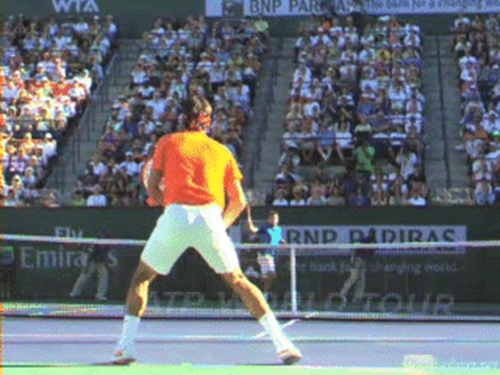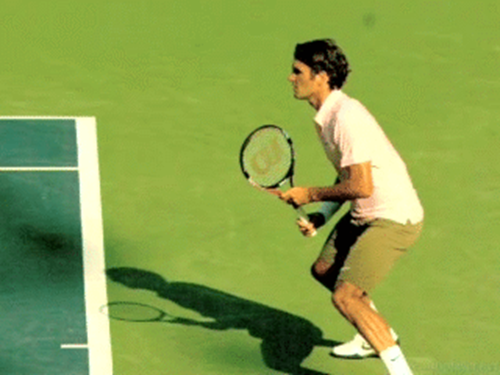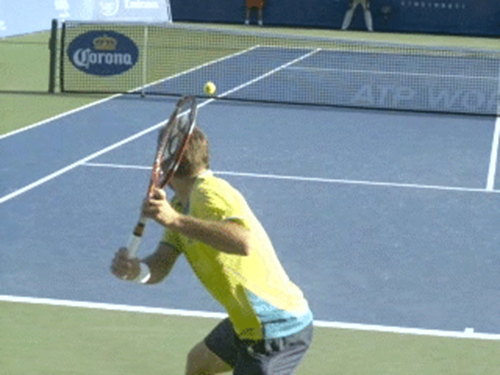1-2 Rhythm
The Single-Handed Backhand
Nick Wheatley
In the first two articles in this series we have looked at a timing concept called 1-2 Rhythm, first for the forehand and then for the two-handed backhand.
Does the same concept apply on the one-handed drive? Yes.
Like other groundstrokes, the one-handed
backhand is hit with 1-2 Rhythm.
What Is it?
1-2 Rhythm breaks down tennis strokes into two parts. Part 1 is the set-up
phase which is slower and feels smooth and deliberate. Part 2 is the execution
phase, which is faster and has a feeling of explosion and high energy.
The concept isn't based on the analysis of technical elements, which
sometimes can lead to paralysis. 1-2 Rhythm overcomes the paralysis issue by
creating a different modality for activating strokes on court.
With 1-2 Rhythm players can execute spontaneously at the actual speed of match play, and also increase energy transfer into the strokes. Why? Because players feel how to hit the ball more naturally--the way most elite players actually learn.
In Phase 1 the racket points behind the player with the
racket head above the hand--the face can be slightly open.
Although it is a different mode, 1-2 Rhythm is compatible and complimentary
with the technical descriptions of the one-hander on Tennisplayer. (Click
Here.) Interestingly, a feel for better rhythm sometimes leads to
spontaneous technical improvements.
One Handed Topspin Backhand
How does 1-2 Rhythm apply to the one-handed backhand drive? There are core
similarities to the other strokes, but also important differences in the timing
of the two phases. The differences in the timing are due to the fundamental
nature of a backhand held only with the dominant hand.
In Phase 1 the
hand and racket travel further behind the body compared to the forehand or the
two hander. The racket head at the completion of Phase 1 is actually pointing
behind the body at the sideline to player's right.
At the completion
of Phase 1, the racket head is also above the height of the hand.
The racket face may be on edge, but for Roger Federer and others it is actually
slightly open.
Phase 2: Acceleration begins with the racket drop and
continues in an explosion through the hit.
Phase 2
The forward swing begins at the start of Phase 2. The racket acceleration begins
as the racket head starts to drop and builds from there.
This acceleration
is further increased at the pro level by the common use of closed stances, set
up by a diagonal cross step. This allows the hips and the shoulders to rotate more
than with a neutral stance at the start of the forward swing--though it is
important to note that there is still far less rotation than on the forehand or
the two-handed backhand.
However, the 1-2 rhythm principle works equally well with neutral or even
open stances. These stances are usually more applicable for lower level
players.
Compare the Phases on the one-hander to the forehand or the two-hander where
the hand and racket stay on the hitting side throughout the motion in the
purest ATP versions of the strokes.
There is another important difference. On the one-hander the racket face doesn't close or tilt
downward as it does on the other two strokes.
With the ATP forehand and two-hander, the hand and racket
stay on the player's hitting side.
But the racket
does slow down or even pause fractionally at the end of this first phase. This
is more like the two-hander than the forehand.
Because players like Federer or Richard Gasquet hit their backhands with
such flowing style, it's sometimes difficult to recognize the explosiveness
involved. But many of the most explosive backhands at the highest levels of the
game are in fact one-handers.
The high energy transfer in Phase 2 may be more apparent in a player like
Stan Wawrinka. When he hits a winner it seems like a canon. In any case, some
the highest backhand velocities at all levels are generated by one handed
players.
The trick to exploding in phase two is to use the front hitting shoulder to swing the arm
and racket without over rotating the body. This
forward action is often dramatically paired with the left arm moving in the opposite direction
with an explosive feel of its own.
As with all shots, 1-2 Rhythm can be activated with simple keys on the
court--usually in the form of one word or image for each phase. For example,
the keys might be as simple as the numbers "1-2" which the player
says to himself.
Stan: a 1-2 Rhythm that resembles firing a canon.
The player should associate the physical feelings of the two technical
phases with the key words, feeling the deliberate coiling during "1"
and the explosive acceleration of the hitting arms with "2."
The duration of "1" should be longer, corresponding with the
slower first phase. "2" should be shorter in duration and possibly
have a more aggressive tone inside the player's mind.
Every player should find the words that work for him, but here are some
other examples that I have found powerful and effective. The first word is
"Smooth." The second word is "Explode." Another combination
is "Slow" then "Fast."
As with the other shots, hitting loose and relaxed is key, and will allow the follow-through to
happen naturally. When 1-2 Rhythm is really working, technique,
feel, and timing are all part of the exquisite experience of hitting a
powerful, well struck one-handed drive. Stay tuned next for the slice!
|
|
Nick Wheatley is an LTA Performance Coach and head coach at Hawker Tennis
in south west London. His junior teams, the Hawker Jets, have won 44
competitions since formation, and over the last 2 years alone, his junior
players have won 19 singles tournaments between them at county level. He has been ranked in the top 75 nationally in 35 and over singles and in
the top 5 in Surrey county. Nick has done video analysis for numerous players
at all levels, including former British Top 10 player Marcus Willis. His unique teaching video series, covering every aspect of the game, is
available on his website www.nickwtennis.com
|






Comments
Post a Comment